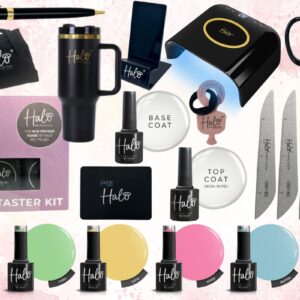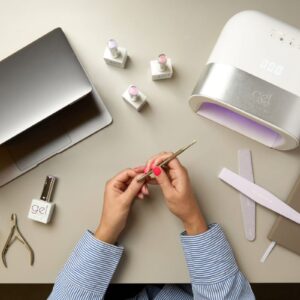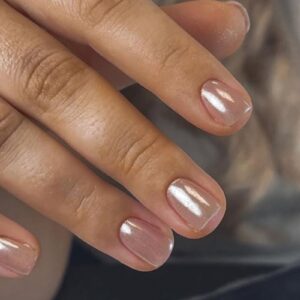
E-files: Understanding use, RPM, torque & more
By Callie Iley | 25 November 2023 | Expert Advice, Feature, Products & Treatments

Get to grips with E-files as Scratch explores use, key features, care tips and more…
The use of an E-file in a nail service can significantly speed up the shaping and filing process, as well as reduce the physically demanding and repetitive use of hand files.

“Some nail technicians are divided over the use of E-files, believing that they damage clients’ nails; but that is not the case if proper training is given,” comments award-winning nail artist & founder of HD Nail Artist Academy, Hazel Dixon.
“An E-file on its own cannot cause any damage to a client’s nails. When the correct drill bits and techniques are used, E-files are perfectly safe.”

“Using an E-file can be more comfortable for clients, with many stating how pleasant and gentle the prep stage feels,” shares Willow educator for South London & Surrey, Annabel Ifill. “When performed correctly, electric manicures can also help heal the skin of nail biters and skin pickers.
“Additionally, using an E-file during an E-pedi can help to resolve dry and calloused heels without the need for intense manual labour.”

“The ability to use specialised bits increases precision and reduces the amount of waste created by traditional disposable hand files,” adds Paulina Zdrada, founder & educator at The Nail Lab. “E-files dramatically reduce the time it takes to prep the nail or remove product, which means less physical strain on the tech.
“However, there are rules to follow to ensure the safe and effective use of an E-file. For example, you should never use a carbide bit designed for debulking on the natural nail.”
Different E-file bits can be used for various purposes, including:
- Removing bulk and lifting.
- Removing dry skin from feet.
- Removing non-living tissue from the cuticle.
- Reducing the length of enhancements.
- Refining product.
- Polishing and exfoliating the skin.
- Cutting out smile lines.
Dissecting RPM

RPM stands for Revolutions Per Minute, which is the speed of the E-file when the bit is spinning in the handpiece.
RPM for E-files can range from 15,000 to 40,000, with the majority of machines having an RPM of around 30,000. “For natural nails, an RPM of at least 15,000 should suffice. Enhancements such as L&P acrylic will require a machine with an RPM of 25,000 or higher,” shares founder of Katie Barnes Tool Range & Education, Katie Clark.
“The faster an E-file can turn, the quicker it can rotate, so the friction against the surface results in quicker removal,” Paulina Zdrada describes. “Having a higher RPM device means you will rarely be using it at its maximum rotation speed, so will be putting your device under less pressure, less often. This will give it a longer life expectancy at full quality.”
Let’s talk torque
Measured in Newton-centimetre (Ncm), torque is the power behind the speed that the E-file uses to rotate, while in contact with a friction point.
“RPM and torque need each other. The torque should be no lower than 2.6 Ncm to avoid feeling any of the stopping that can happen on a less powerful device,” Paulina Zdrada comments. “The higher the torque, the more room the device has in terms of working without being maxed out.”
“A good quality E-file should be able to maintain the same speed and rotational power, whether it’s spinning in the air or being used on a nail,” Hazel Dixon observes. “Techs who have a low torque E-file will find themselves applying more pressure or increasing the speed of their E-file to compensate for the loss in power, which can lead to excessive heat, damage to the nail plate and quick wear of the bits.
“With a high torque E-file, only a light touch is needed – the bits and the motor will do most of the work for you.”
“Most low-quality E-files have a low torque, so will struggle to maintain speed and power, making them noisy with high vibration,” shares Annabel Ifill. “The E-file is having to work twice as hard, causing the tech to work twice as hard, which creates substandard results and can cause issues such as RSI for the tech and nail separation for the client.”
Taking care of your E-file

KB E-file Dust Caps Pack of 10, www.katiebarnesacademy.com
Taking good care of your E-file will maintain its longevity and ensure that your nail services stay on top form.
“One of the most important things you can do to maintain and care for an E-file is to use dust caps on your bits,” Paulina Zdrada recommends. “When dust enters your handpiece and starts to build up, it can heavily impact the motor’s ability to operate smoothly and quietly.
“Extreme build-up of dust can also cause heat to be generated as a result of the internal friction between the dust and rotating elements of your motor, which could terminally damage your device,” Paulina Zdrada continues. “Other things you can do to maintain and care for your device include making sure that you avoid exposure to water, acetone or alcohol-based products.”
“Get your E-file serviced every six to 12 months, to ensure any dust build-up is thoroughly removed,” adds Annabel Ifill. “Do not change the direction of the motor while the bit is in use, as this can affect the motor, and don’t use portable machines while they’re charging, as this can affect battery life.”
Desktop vs portable
Desktop machines are generally more powerful than portable models, with portable E-file machines having a lower torque due to their rechargeable batteries and slimline handpieces. “This doesn’t mean portable E-files with high torque aren’t powerful or fit for purpose,” shares Annabel Ifill.
“Techs need to assess working conditions and preferences, to choose whether a portable or desktop E-file is more suitable for them.
“Nail technicians that offer L&P acrylic infills or dry pedicures, or techs that work full=time and see many clients each day, may be better suited to a high torque desktop E-file machine. Nail technicians that work part-time, or mainly with gel products and on natural nails, may be better suited to a portable machine.”

Read the latest issue









